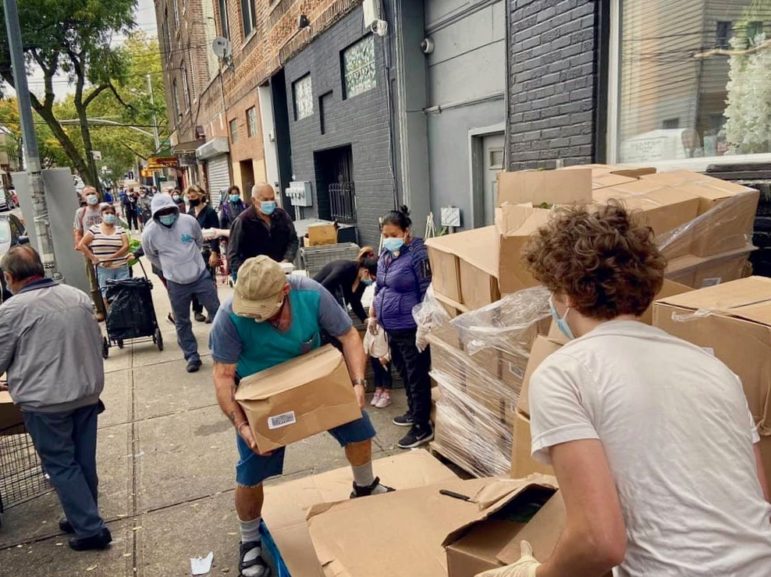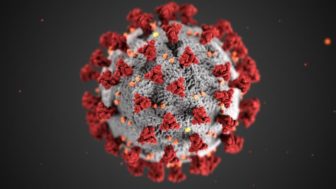It’s been more than seven months since New York started coronavirus lockdown measures, and just as the crisis itself has shifted and evolved over time, so too have the informal networks of volunteers and neighbors working to help one another endure it.

Courtesty Woodbine NYC
Queens organization Woodbine has been hosting a food pantry in Ridgewood since the start of the pandemic.When Edie Meyer first started volunteering with her local mutual aid network, East Village Neighbors, at the start of the COVID-19 outbreak this spring, the group’s work consisted largely of running errands for those who couldn’t risk the trip to the grocery store or the pharmacy. The neighbor in need would reimburse a volunteer, who would head to the store on their behalf.
But as the pandemic progressed, it soon became clear that the group would need to adjust its model: It was getting more requests from people who needed those grocery delivered—but who also couldn’t afford the food.
“People really ran out of money right away,” says Meyer, who coordinates volunteers and does dispatch work for East Village Neighbors, one of dozens of mutual aid networks formed this spring in the wake of the lockdown. She recalled getting a shopping trip request from one resident in particular that “just broke my heart.”
“She texted me and said, ‘I’m so embarrassed, but I don’t have $30,” Meyer says. So the group started a fundraising page to pay for emergency groceries in those situations. “There were more and more people who really needed some help.”
It’s been more than seven months since New York started coronavirus lockdown measures, and just as the crisis itself has shifted and evolved over time, so too have the informal networks of volunteers and neighbors working to help one another endure it. Mutual aid groups say they’ve tweaked and expanded their services. They’ve endured financial dry spells and have tried new ways to raise money and recruit members, posting on neighborhood listservs and holding fundraiser bake sales.
As the economic downturn spurred by the pandemic drags on, many of these groups say they’re also now positioning themselves to help address other emerging needs: Not just errands and food insecurity—the demand for which remains high, and growing—but also assisting those at risk of losing their housing or who can’t afford childcare.
“I think people are really suffering with the lack of extension,” of relief benefits, says Matt Peterson, an organizer with Woodbine, a communal hub in Ridgewood, Queens. They started doing mutual aid work at the start of the pandemic, when things were in “emergency disaster mode.”
Though they’re still continuing that work, including a biweekly food pantry, “the culture of it feels a bit different now,” Peterson says.
“We’re meeting needs in the neighborhood, but it’s less about this emergency disaster” and more like they’re filling a need that existed long before the pandemic, but has worsened now. “In some ways, it shifted from being disaster relief…to something close to poverty relief.”
While New York City has kept COVID-19’s viral impact at bay for the past few months—the daily death toll has hit double digits just once in the past three months—the economic symptoms are as present as ever. The city’s unemployment rate was 13.9 percent in September, and more than 28,000 people filed new unemployment claims last week, 460 percent higher than the same week in 2019.
Filling gaps
Like East Village Neighbors, when the West Brooklyn Waterfront Mutual Aid group started up in the spring, it was mostly performing tasks outside the home for older and at-risk neighbors, says Suzanne Boswell, who’s been volunteering with the network since April.
“Very quickly after I started, it shifted from people who just needed grocery deliveries and were staying inside because of the pandemic to suddenly, we had this surge of people who need food support—so financial support, essentially,” Boswell says.
That need, she adds, has grown exponentially since, and so has the scope of their work: During the last two weeks of June, the group delivered food to 38 people; during the first two weeks of October, they served 115 neighbors, plus another 75 people they delivered bulk groceries to in Canarsie. They’ve taken on other tasks too, like delivering air conditioners to local seniors during the summer’s heat wave.
“The pandemic has shown us this gap and we had the opportunity to fill it,” says Boswell.
For some groups, filling those gaps has meant an array of miscellaneous tasks: tracking down cleaning supplies or PPE for members of multi-generational households who need to take extra precautions, sourcing cat food for one neighbor who needed it and finding someone to dog-sit for a couple who both came down with COVID-19 and had to go to the hospital.
Mutual aid volunteers are also planning ahead, anticipating where the most pressing needs will come from next. Many agree that housing insecurity looms large, especially as the state’s eviction moratorium—which advocates have argued still does not do enough to protect many tenants—is slated to expire at the end of the year.
“Evictions keep me up at night,” says Maryam Shariat Mudrick, who started the Astoria Mutual Aid Network with her husband back in March, after losing her job in the events sector. The group has been in conversation with advocates like the Astoria Tenant Union on ways to best support community members whose housing is at risk, she says.
Khaela Maricich, who works doing outreach with the West Brooklyn Waterfront Mutual Aid, is also part of a housing working group for Mutual Aid NYC, an umbrella organization that helps coordinate various volunteer networks across the city. There, activists are already doing work around housing: helping tenants who get rental assistance in finding apartments that accept housing vouchers, and helping them furnish their units by sourcing free items off sites like Craigslist and Buy Nothing. Some organizers are also holding “mutual aid eviction blockades,” Maricich says, where volunteers will sit on a stoop in support of a neighbor being illegally evicted.
Shariat Mudrick says Astoria Mutual Aid is also preparing for the months ahead by organizing a cold weather-coat drive. She’s particularly worried, she says, about how the city’s houseless population will fare over the next several months.
“It’s starting to get cold and if people don’t have shoes, coats, gloves, jackets, we’re going to see people freezing to death this winter,” she says.
Finding funds and manpower
As the city enters its eighth month of the pandemic, mutual aid organizers have had to adjust their operations to keep things running.“Reflecting back on March, we had no idea what the timeline for this was,” says Shariat Mudrick, who says running Astoria Mutual Aid is now essentially her full-time job. For months, the group had sufficient funding to cover its expenses, raising money through online crowdsourcing platforms like Ioby, but they’ve recently hit a dry spell.
“We’re getting toward the final of the bits of our funds raised,” she says. Donations have been decreasing each month for the last six months, forcing them to cut back some of their services, like paying for the cab rides of people who need to get to medical appointments. “As of Nov. 1, we can’t afford it anymore.”
She attributes the dropoff in support to a number of potential factors: People are distracted by the upcoming election, and perhaps donating to political campaigns instead. The fall and winter are also a busy season for many, “always a time when people have too much on their plate.”
But COVID fatigue is a factor, too.
“Honestly, I think a lot of people have gotten used to COVID,” Shariat Mudrick says. “I think everyone’s tired.”
For the West Brooklyn Waterfront Mutual Aid, the well ran dry over the summer, in terms of volunteers: In July and August, the group had to pause taking new dispatch requests due to a shortage of manpower. They had to find ways to re-engage people, something that was easier at the beginning of lockdown when “everyone had all this free time,” says Boswell.
“I think it’s something that all mutual aids are really thinking about,” she adds. “How do we make this something that people feel is sustainable and part of their everyday life…that doesn’t feel massively overwhelming?”
They’ve had success in recruiting volunteers through sites like NextDoor and Buy Nothing, where they’ll post about a task they need doing: someone to deliver something or to bake items for a fundraiser bake sale. The efforts have paid off, and while it used to take up to seven days for the group to fulfill a request for help, it can now take as little as two to three. They’ve also successfully expanded their budget through fundraising.
“We did a lot of outreach, we built up more infrastructure and we got an influx of both new volunteers and older volunteers who came back,” Boswell says.
‘Like a nervous system’
At Woodbine in Queens, Peterson says they’ve seen some of the community residents who they’ve helped through their mutual aid work return as volunteers: Those who initially lined up at their weekly food pantry later came back to help hand out food themselves.
“It’s kind of blurring the lines, which is really the idea,” of mutual aid, he says. It helped that Woodbine had already been doing service work in their Ridewood neighborhood prior to COVID-19, including running a community garden farm share since 2015.
“Those things really allowed us to meet a lot of people in the neighborhood over the years,” he says. “We were really able to mobilize that.”
Also key is partnering with other organizations. Woodbine, for example, has teamed up with social services provider Hungry Monk, and alternated with them on their food pantry days. East Village Neighbors has worked with the Sixth Street Community Center to host a food pantry, and also helps those who reach out in need by referring them to existing resources, both public and private.
“The different resources that the city has that sometimes are just not easy to figure out, especially if you’re older and not as tech savvy,” Meyer says.
Linking the various mutual aid networks, city nonprofits and public city services is essential to making this type of work sustainable in the long term and to meeting the needs of more New Yorkers, organizers say.
“Connecting the resources of relationships that already exist, expanding the circle,” Maricich says. “Kind of to work like a nervous system.”
It’s about “building the capacity within the community,” Shariat Mudrick explains, so even if a particular mutual aid group disbands, those connections will still be there to respond.
“My hope is that the ghost of the Astoria Mutual Aid Network will always be present through the capacity work,” she says. “We now have a system and channels and infrastructure that we didn’t have before.”










One thought on “Months into Pandemic, City’s Mutual Aid Networks Evolve to Meet New Need”
If you’re interested in volunteering with West Brooklyn Waterfront mutual aid, please visit us here! https://www.wbwmutualaid.org/